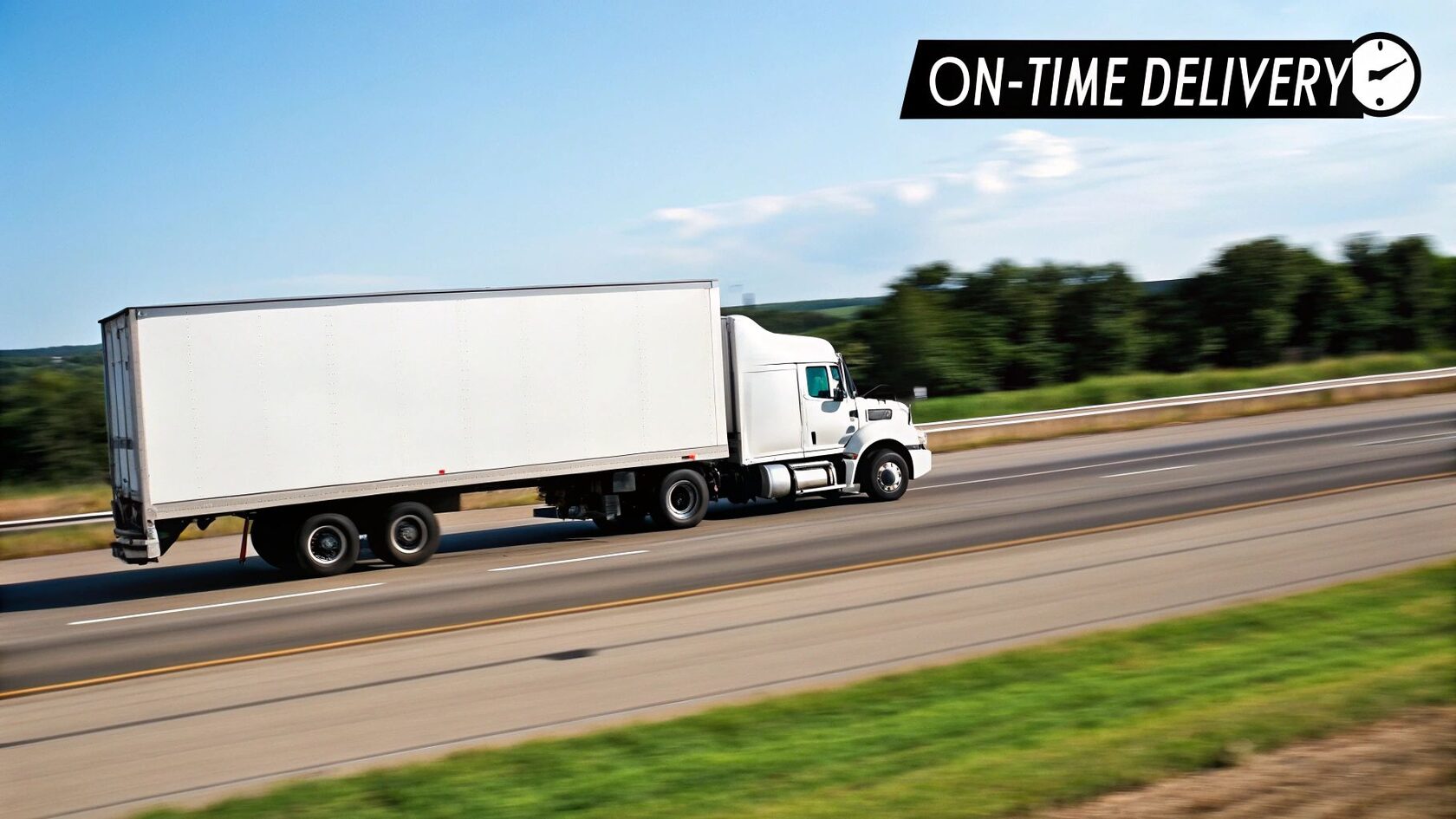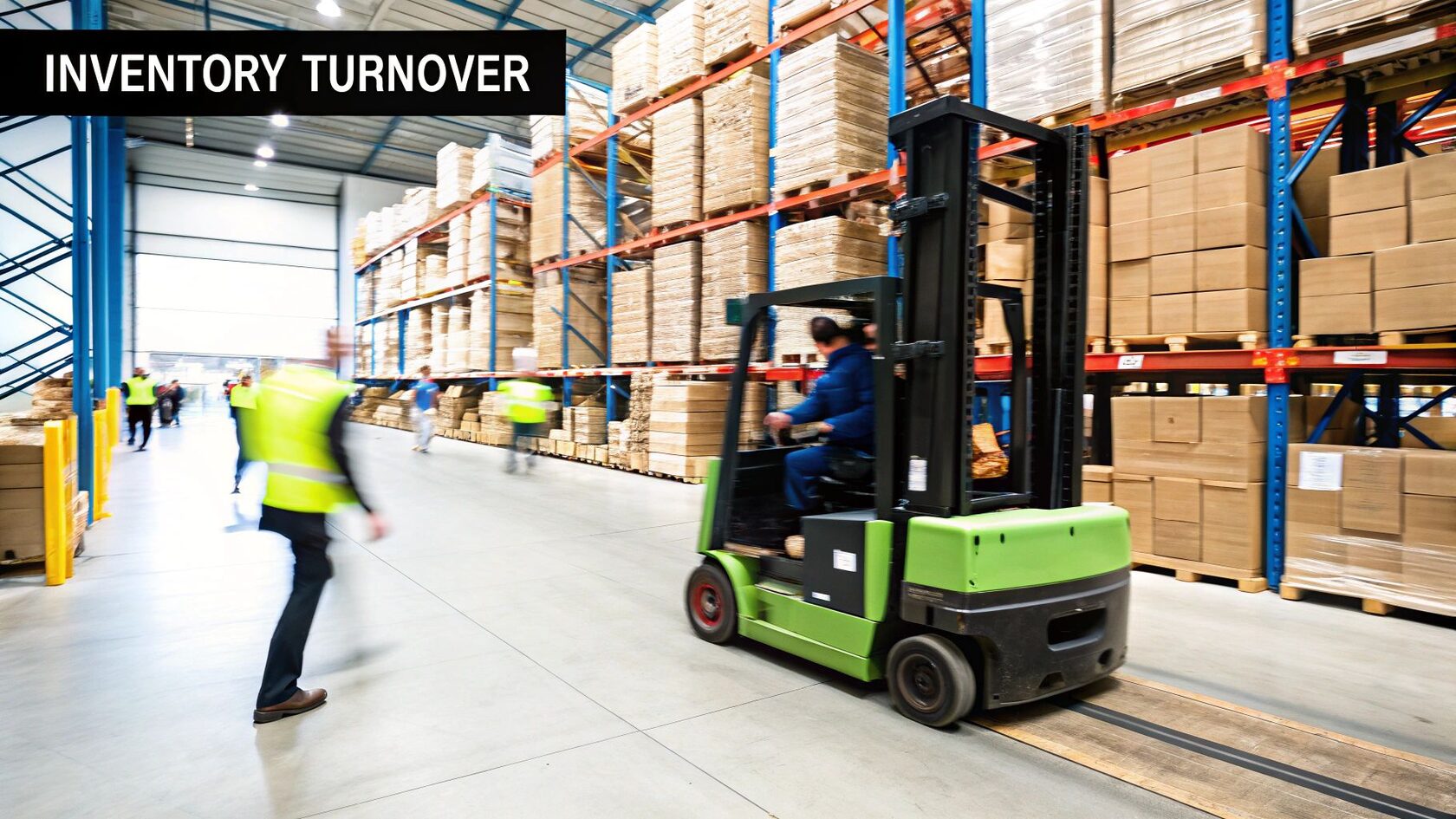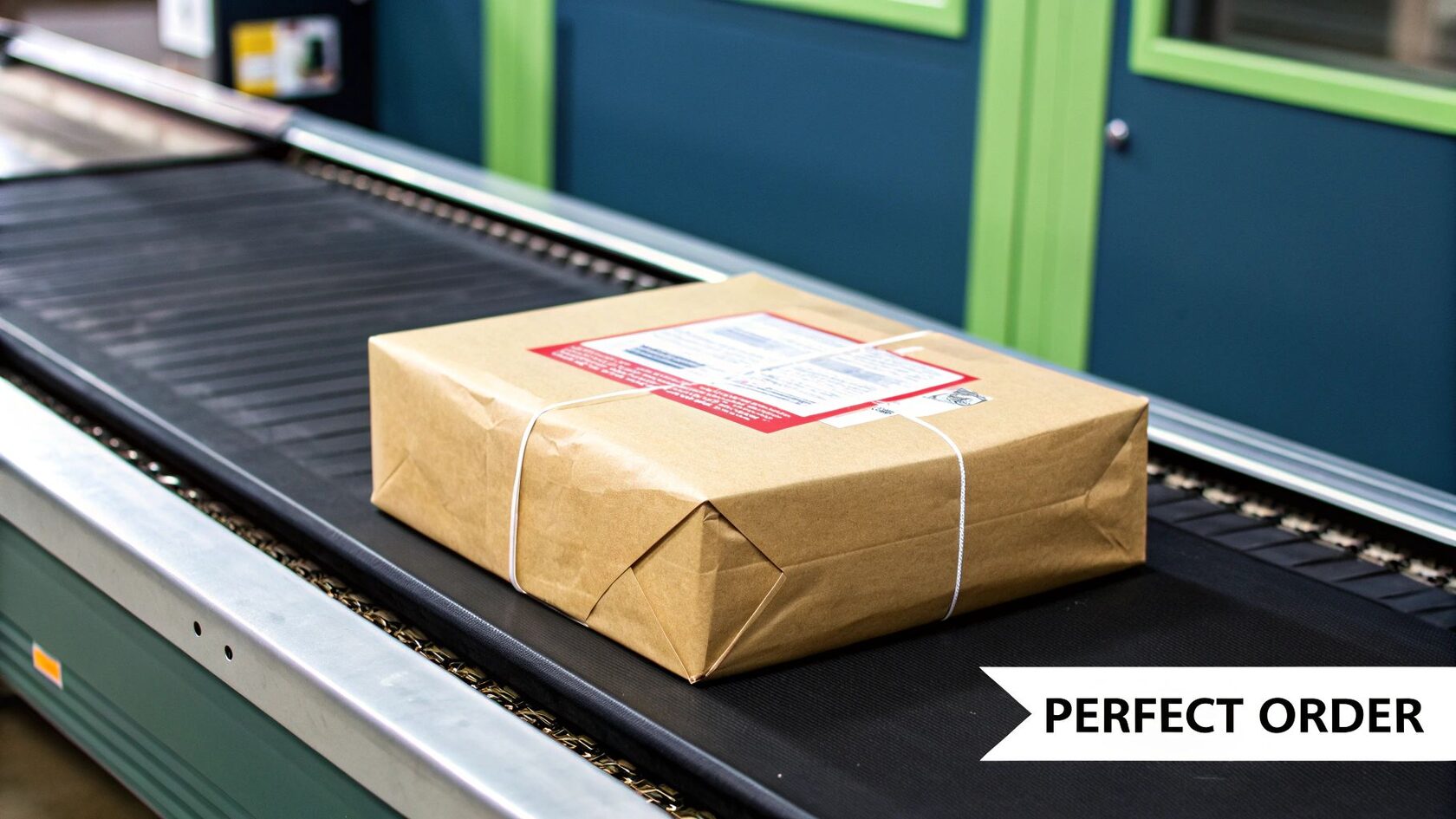7 Key Logistics Performance Metrics to Track in 2025
In the high-stakes world of freight, what you measure is what you manage. Simply moving goods from point A to point B is no longer enough to guarantee success. To thrive, motor carriers must meticulously track key logistics performance metrics to optimize operations, enhance profitability, and build an unbreakable reputation with brokers and shippers. These metrics are more than just numbers on a dashboard; they are the vital signs of your business, directly impacting your ability to secure profitable loads and avoid negative reports.
A strong performance record, backed by solid data, is your best defense against operational setbacks and damaging listings on platforms like FreightGuard or Carrier411. This guide moves beyond theory to provide a practical breakdown of the seven most critical metrics every carrier needs to master. We will detail the formulas, industry benchmarks, and actionable strategies to implement immediately.
Understanding and improving these KPIs is the first step toward not only restoring your reputation but also achieving long-term excellence. For carriers navigating the fallout from negative reports, be wary of service providers demanding large upfront payments, as the industry has its share of scammers. Carriers have to be careful when they are asked to do an upfront payment. Reputable partners, like our company - FreightGuard Removal - stand out among others because we offer solutions without requiring any upfront payments, demonstrating confidence in our results. This article provides the operational blueprint to strengthen your performance from the inside out.
1. On-Time Delivery Rate (OTDR)
On-Time Delivery Rate (OTDR) is arguably the cornerstone of all logistics performance metrics. It calculates the percentage of orders delivered to the customer within the promised delivery window. For motor carriers, a high OTDR is not just a number; it's a direct reflection of your reliability and commitment, significantly influencing customer trust, retention, and your overall reputation in a competitive market. Consistently hitting delivery targets can be the difference between securing premium loads and struggling for contracts.

This metric is vital because it directly impacts the end-customer's experience. A late delivery can disrupt a customer’s entire supply chain, leading to production halts, stockouts, and financial losses. Consequently, brokers and shippers scrutinize a carrier’s OTDR before entrusting them with valuable freight. A pattern of late deliveries can quickly lead to negative reviews and reports on platforms like Carrier411 and FreightGuard, damaging your MC record and limiting your access to quality loads.
How to Implement and Improve OTDR
Successfully tracking and improving OTDR requires a strategic approach rather than just recording failures. It's about building a resilient and predictable operation that consistently meets expectations.
Actionable Implementation Tips:
- Establish Clear Definitions: What constitutes "on-time"? Is it arrival at the gate or when the trailer doors are opened? Define this clearly with your shipping partners and document it in your service level agreements (SLAs) to avoid disputes.
- Utilize Technology: Implement real-time GPS tracking and Transportation Management Systems (TMS). This technology provides immediate visibility into shipment progress, allowing for proactive intervention if a delay seems likely.
- Conduct Root Cause Analysis: Don't just log a late delivery. Investigate the why. Was it due to unexpected traffic, long detention times at the shipper's facility, mechanical failure, or poor route planning? Use a simple checklist for drivers to report delay reasons, providing you with structured data to analyze.
- Proactive Communication: If a delay is unavoidable, communicate it to the broker and receiver immediately. Proactive honesty is often better received than a surprise failure and can prevent a negative report.
Key Insight: A world-class OTDR isn't about never being late; it's about building systems that anticipate potential delays and communicating transparently when they occur. Leading carriers like FedEx and UPS have mastered this, achieving over 95% on-time performance by integrating predictive analytics and robust communication protocols. This is a benchmark all carriers should strive for to remain competitive.
2. Order Accuracy Rate
Order Accuracy Rate measures the percentage of orders delivered to the customer perfectly, meaning the right products, in the right quantities, and free from damage. While often associated with warehouse operations, this is a critical logistics performance metric for carriers because what happens in the trailer directly impacts the final delivery outcome. A high order accuracy rate signals a detail-oriented and reliable partner, minimizing costly returns, chargebacks, and customer dissatisfaction.

This metric is vital because inaccuracies erode trust and profit. Delivering the wrong item or a damaged shipment forces the customer to initiate a return, creates logistical headaches for everyone involved, and often results in a refusal or a claim. For brokers and shippers, an error-prone carrier is a liability that can damage their own customer relationships. These incidents can lead to negative reports on platforms like Carrier411 and FreightGuard, tarnishing your MC record and making it harder to secure high-value freight from quality partners.
How to Implement and Improve Order Accuracy
Improving order accuracy requires a focus on processes that prevent errors before a truck is even loaded. It's about ensuring the integrity of the freight from the moment it's in your care until it's signed for at the destination.
Actionable Implementation Tips:
- Implement Strict Loading Protocols: Train drivers and loaders to verify pallet counts, check for visible damage, and confirm shipping labels against the Bill of Lading (BOL) before loading. A simple checklist can formalize this process.
- Use Technology for Verification: Encourage the use of barcode scanners or smartphone apps to confirm shipment details during pickup. This adds a layer of digital verification that catches errors paperwork might miss.
- Analyze Error Patterns: When an error occurs, document it meticulously. Was it a short shipment, an overage, or damage? Track these incidents to identify patterns. Are errors happening more frequently from a specific distribution center or with a particular type of freight?
- Secure Loads Properly: Improperly secured freight is a leading cause of in-transit damage, a key component of order inaccuracy. Invest in training and equipment like straps, dunnage, and load bars to ensure everything stays put.
Key Insight: Elite logistics operations view accuracy as a non-negotiable standard. Pharmaceutical distributors, for example, must maintain near-perfect 99.9%+ accuracy for safety and compliance. While not all freight is as sensitive, adopting this mindset sets you apart. Achieving 99%+ accuracy demonstrates a commitment to excellence that premium shippers and brokers are willing to pay for.
3. Inventory Turnover Rate
Inventory Turnover Rate is a critical financial and operational metric that measures how many times inventory is sold and replenished over a specific period, typically a year. While it may seem more relevant to shippers and retailers, carriers who offer warehousing or value-added services must pay close attention. It reveals the efficiency of both sales efforts and inventory management, directly impacting cash flow and profitability. A high turnover rate signifies that goods are moving quickly, preventing capital from being tied up in stagnant stock.

This metric is essential because it highlights the health of a supply chain. For carriers involved in dedicated contracts or inventory management, a low turnover rate can indicate overstocking, poor demand forecasting, or obsolete products, all of which lead to increased holding costs and wasted warehouse space. Conversely, an extremely high rate might signal under-stocking, which can result in stockouts and missed sales opportunities for the customer. Understanding this balance is key to providing strategic value beyond simple transportation.
How to Implement and Improve Inventory Turnover
Improving inventory turnover is about synchronizing supply with demand and creating a lean, responsive logistics operation. This requires a deep understanding of the products you handle and the market they serve.
Actionable Implementation Tips:
- Segment Your Inventory: Use ABC analysis to categorize products based on their value and sales frequency. Focus your optimization efforts on "A" items, which represent the highest value, to make the biggest impact on cash flow.
- Balance with Service Levels: Do not chase a higher turnover rate at the expense of customer service. Ensure that optimizing inventory levels does not lead to frequent stockouts that disrupt your client's operations. Align turnover goals with agreed-upon service levels.
- Factor in Lead Times: Accurately account for supplier lead times and transportation transit times in your replenishment calculations. Unreliable lead times can force you to hold more safety stock, which directly lowers your turnover rate.
- Collaborate with Partners: Share sales data and forecasts with your shipping partners and suppliers. This transparency allows for better planning across the entire supply chain, reducing the need for excess inventory buffers.
Key Insight: Elite supply chain operators master this metric by treating inventory as a fluid asset, not a static cost. For example, Zara's fast-fashion model achieves over 12 turns annually by tightly integrating design, production, and logistics. Similarly, grocery giants like Kroger maintain 10-14 turns by using sophisticated demand forecasting and just-in-time replenishment, a benchmark for efficiency in any inventory-dependent operation.
4. Transportation Cost per Unit
Transportation Cost per Unit is a fundamental logistics performance metric that isolates the expense of moving a single item, whether it's a pallet, case, or individual product, from origin to destination. For motor carriers, understanding this metric is critical for maintaining profitability. It moves beyond a simple cost-per-mile calculation to provide a granular view of your operational efficiency, allowing for more strategic pricing and smarter load selection. Knowing your precise cost per unit helps you determine if a particular lane or type of freight is truly profitable for your business.

This metric is essential because it directly ties your transportation activities to financial outcomes. A low cost per unit can give you a competitive edge in bidding for contracts, while a high cost may signal inefficiencies that are eroding your margins. Shippers and brokers often analyze this data to optimize their own supply chains, favoring carriers who can provide value without sacrificing service quality. Consistently managing and reducing this cost demonstrates operational excellence, making your carrier service more attractive to high-value partners.
How to Implement and Improve Transportation Cost per Unit
To effectively manage and lower your cost per unit, you must move from broad estimates to detailed, data-driven analysis. It’s about understanding every dollar spent and how it contributes to moving freight.
Actionable Implementation Tips:
- Include All Cost Components: Don't just factor in fuel and labor. Your calculation must be comprehensive and include insurance, maintenance, tolls, tires, and even administrative overhead. This provides a true total cost of ownership.
- Track Costs Granularly: Use your TMS or accounting software to track expenses by route, truck, and customer. This allows you to identify which lanes are most profitable and which might be losing you money.
- Leverage Route Optimization: Implement technology to find the most efficient routes. This goes beyond the shortest distance and considers factors like traffic patterns, fuel costs, tolls, and driver hours-of-service limitations.
- Maximize Asset Utilization: Minimize empty miles and excessive dwell time. Every moment a truck is sitting idle or running empty increases your cost per unit for the loads it does carry.
Key Insight: Elite logistics operations, like those at Amazon and Coca-Cola, obsess over this metric. They have achieved massive savings not just by negotiating fuel prices, but by redesigning entire networks and using sophisticated software to optimize every single load. Carriers can adopt this mindset by analyzing their own data to find hidden opportunities for efficiency, turning cost savings directly into profit.
5. Perfect Order Rate
The Perfect Order Rate (POR) is a comprehensive, all-in-one metric that measures the percentage of orders delivered without any incidents. An order is only considered "perfect" if it is delivered complete, on time, damage-free, and with accurate documentation. This metric is one of the most crucial customer-facing logistics performance metrics because it bundles multiple critical success factors into a single, powerful indicator of overall service quality and operational excellence.
For a motor carrier, achieving a high POR demonstrates a mastery over the entire logistics process, not just a single element like timeliness. This holistic view is exactly what high-value shippers and brokers look for. It proves you can handle their freight flawlessly from pickup to drop-off, minimizing any potential for supply chain disruption, administrative errors, or product loss. A low POR, conversely, signals systemic issues that could lead to costly claims, dissatisfied customers, and negative reports that tarnish your reputation.
How to Implement and Improve POR
Improving your Perfect Order Rate is about achieving operational harmony across all touchpoints. It requires a cross-functional focus on quality control and process discipline, rather than just fixing one-off mistakes.
Actionable Implementation Tips:
- Deconstruct and Measure: Break down the "perfect order" into its four core components: on-time, complete, damage-free, and accurate documentation. Start by tracking your performance for each component individually. This will help you pinpoint your weakest link and focus your improvement efforts where they will have the most impact.
- Implement Quality Checkpoints: Introduce verification steps throughout the shipping process. For example, use a pre-loading checklist to confirm freight counts and condition, a mid-transit check to verify ETA, and a post-delivery process to confirm all paperwork is signed and submitted correctly and promptly.
- Conduct Rigorous Root Cause Analysis: When an order is not perfect, dig deep to find the root cause. Was the damage due to improper loading? Was the documentation error a result of a driver training gap or a faulty data entry process? Addressing the fundamental cause prevents the same failure from recurring.
- Standardize Processes: Create and enforce Standard Operating Procedures (SOPs) for key activities like freight handling, document submission, and communication protocols. Consistency is the foundation of a high Perfect Order Rate.
Key Insight: The Perfect Order Rate is the ultimate test of your logistics capabilities. Best-in-class companies, like pharmaceutical distributors, often maintain PORs above 98% because their products' integrity is non-negotiable. While this is a high bar, striving for it forces a carrier to eliminate operational inefficiencies and elevate their service to a premium level, making them an indispensable partner to shippers.
6. Warehouse Productivity (Orders per Hour)
While many carriers focus solely on in-transit metrics, warehouse productivity is a critical component of the end-to-end logistics chain. This metric, often measured in orders processed per hour, quantifies the efficiency of your warehouse or cross-docking operations. For LTL carriers or those offering warehousing services, high productivity is a direct measure of operational excellence, translating into lower labor costs, faster turnaround times, and increased capacity. It’s a key performance indicator that shows brokers and shippers your ability to manage freight efficiently on the ground, not just on the road.
This metric is vital because inefficient warehouse operations create bottlenecks that ripple through the entire supply chain. Slow order picking, packing, or loading can delay departures, jeopardizing your On-Time Delivery Rate (OTDR) before a truck even leaves the yard. For shippers, this inefficiency means higher costs and slower speed to market. A well-run warehouse, demonstrated by strong productivity numbers, becomes a significant competitive advantage, allowing you to handle more volume reliably and attract more lucrative, high-turnover freight contracts.
How to Implement and Improve Warehouse Productivity
Boosting warehouse productivity involves a systematic focus on process optimization, employee empowerment, and technology adoption. It's about minimizing wasted movement and maximizing value-added activities.
Actionable Implementation Tips:
- Balance with Accuracy: Don't chase speed at the expense of accuracy. Track picking and packing errors alongside productivity. A fast operation that ships incorrect orders is ultimately counterproductive and can lead to costly returns and negative reports.
- Invest in Ergonomics and Training: A comfortable, well-trained worker is a productive one. Implement ergonomic improvements like anti-fatigue mats and adjustable workstations. Provide thorough training on optimal picking paths and proper equipment use to ensure both safety and efficiency.
- Use Technology to Eliminate Waste: Implement a Warehouse Management System (WMS) to optimize pick paths and inventory slotting. Use barcode scanners and mobile devices to reduce manual data entry and minimize non-value-added activities like searching for items or paperwork.
- Consider Order Complexity: Not all orders are equal. A single-item order is much faster to process than a multi-line order with various items. Segment your productivity tracking by order type to set realistic benchmarks and identify specific areas for improvement.
Key Insight: World-class warehouse operations, like those at Amazon or FedEx Ground facilities, are built on a foundation of continuous improvement and smart technology. Amazon's use of robotics to bring shelves to pickers has dramatically increased picks per hour, while FedEx's automated sorting systems handle thousands of packages per hour. The underlying principle is to let technology handle repetitive, strenuous tasks, freeing up human workers for more complex, value-added functions. This strategic blend of human skill and automation is the benchmark for modern logistics productivity.
7. Freight Bill Accuracy
Freight Bill Accuracy is a critical, though often overlooked, logistics performance metric that measures the percentage of invoices received from partners that are error-free. For motor carriers, this metric is a two-way street; it reflects both the accuracy of your own billing processes and the reliability of payments from brokers and shippers. It's a direct indicator of your operational and financial discipline, impacting cash flow, administrative workload, and partner relationships. Consistently accurate billing builds trust and streamlines payments, while frequent errors lead to disputes, delays, and costly reconciliation efforts.
This metric is vital because inaccuracies can silently drain your profits. Overcharges from suppliers or underpayments from customers directly erode your margins. Furthermore, resolving billing disputes consumes valuable administrative time that could be spent on revenue-generating activities. For brokers and shippers, a carrier with a history of billing errors is a red flag, suggesting disorganization that might extend to other areas of their service, potentially leading to damaged partnerships.
How to Implement and Improve Freight Bill Accuracy
Achieving high freight bill accuracy requires meticulous data management and standardized processes. It’s about creating a system that minimizes human error and ensures every invoice aligns perfectly with the agreed-upon terms.
Actionable Implementation Tips:
- Standardize Rate Confirmations: Ensure every rate confirmation is detailed and clear. It should explicitly state the linehaul rate, fuel surcharge, and any potential accessorial charges like detention, layover, or lumper fees. This document is your primary source of truth.
- Implement a Pre-Billing Audit: Before sending an invoice, have a second person or an automated system check it against the rate confirmation and the signed Bill of Lading (BOL). This simple two-step verification can catch the majority of errors.
- Maintain Master Data: Keep an updated and accurate master file of your customer rates and contracts within your Transportation Management System (TMS). This allows for automated validation and reduces manual entry mistakes.
- Establish a Clear Dispute Process: When a customer disputes an invoice, have a formal process to investigate and resolve it quickly. Document every step to identify recurring issues, whether they stem from your end or the customer’s.
Key Insight: Top-tier carriers and large shippers like Amazon and Walmart aim for over 98% freight bill accuracy by leveraging automated freight audit and payment (FAP) systems. Companies like Cass Information Systems and nVision Global specialize in this, but carriers can adopt the same principles. By integrating your TMS with accounting software, you can automate invoice generation and verification, transforming billing from a manual chore into a strategic financial advantage.
Metric Implementation Complexity 🔄 Resource Requirements ⚡ Expected Outcomes 📊 Ideal Use Cases 💡 Key Advantages ⭐
Protecting Your Performance and Your Reputation
Mastering the seven logistics performance metrics detailed in this guide, from On-Time Delivery Rate to Freight Bill Accuracy, is the foundation of a successful and profitable trucking operation. These KPIs are not just numbers on a dashboard; they are the vital signs of your business, signaling your health, efficiency, and reliability to the brokers and shippers who control your revenue stream. Consistently strong performance in these areas is your best offense in a competitive market.
However, a strong offense needs an equally strong defense. In today's digital-first logistics landscape, your reputation is as tangible as your fleet. A single negative or fraudulent report filed on a platform like Carrier411 or FreightGuard can instantly invalidate months of stellar performance, effectively blocking your access to quality loads and putting your business on hold. This is where proactive reputation management becomes a non-negotiable part of your operational strategy.
Navigating the Risks of Reputation Management
Unfortunately, the urgency to clear a negative report has attracted opportunistic scammers. Many carriers, desperate to get their MC number cleared and their trucks moving again, fall victim to companies demanding large upfront payments for "guaranteed" removal services, only to disappear once the payment is made. There are many scammers in this industry, so carriers have to be careful when they are asked to do an upfront payment. This adds financial injury to reputational insult.
Crucial Warning: Be extremely wary of any service that requires payment before they have delivered a successful result. A legitimate partner is confident in their ability to perform and will align their success with yours.
This is precisely why our approach at FreightGuard Removal is different. We understand the financial pressure you're under, which is why we never ask for any upfront payments. Our company stands out among others because our model is built entirely on success. We get to work on your case, whether it involves a legitimate service failure, a misunderstanding, or a completely fraudulent claim, and you only pay us after the negative report has been successfully removed and your record is clean. This risk-free approach ensures your protection and demonstrates our commitment to delivering real results.
The Path Forward: Integrating Performance and Protection
Ultimately, securing the long-term success of your carrier business requires a two-pronged approach:
- Internal Excellence: Continuously track, analyze, and improve your core logistics performance metrics. Use the insights from your OTDR, order accuracy, and transportation costs to build a lean, reliable, and efficient operation that shippers and brokers love.
- External Vigilance: Actively monitor your public-facing reputation on critical industry platforms. Treat your MC record's health with the same seriousness as your fleet's maintenance schedule, and partner with a trustworthy expert to handle any issues that arise.
By weaving these two strategies together, you create a resilient business that not only performs at a high level but is also shielded from the external threats that can derail even the best-run carriers. Don't let your hard-earned performance be undermined by a mark on your record. Protect your operations, protect your reputation, and keep your business thriving.
Is a negative FreightGuard on Carrier411 report holding your business back? Don't risk your money on empty promises. Contact FreightGuard Removal today for a no-risk consultation and let us restore your reputation, with no upfront payment required. Get your MC record cleaned with FreightGuard Removal.
